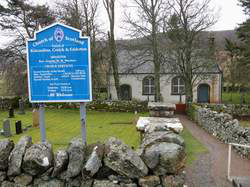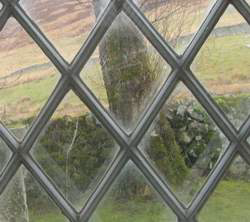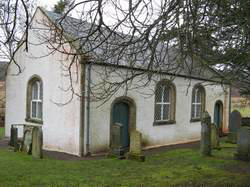Abandoned Communities ..... Strathcarron
The Times correspondent pointed out that one reason why landowners in surrounding communities may have been reluctant to allow people from Glencalvie to stay on their land was their anxiety about the likely implications of the impending Scotch Poor Law. This law was expected to impose additional responsibilities on landowners for the support of poor people living within their boundaries.
Another long article appeared in The Times on 2 June. Early in this article the correspondent commented on the calm manner in which the people of Glenacalvie had submitted to their eviction. He noted that “these poor Highlanders”, apart from their naturally mild and passive nature, had been so broken in spirit that not a murmur, not a remonstrance, escaped them in the completion of this “most heartless wholesale ejectment.”
On Sunday 25 May the correspondent travelled along Strathcarron towards the church at Croick. Close to a bridge he joined a gathering of about 250 people that included the inhabitants of Glencalvie and others from neighbouring valleys. They were seated in a circle on the hillside. The women were neatly dressed in net caps, with scarlet or plaid shawls, the men wore blue bonnets, and had their shepherd’s plaids wrapped round them. They were facing one of their elders, who was reading psalms to them in the Gaelic language.
When the correspondent reached the church he found that a long booth or tent had been constructed in the churchyard. An elderly pensioner and one family had been allowed to stay in their homes, but the remaining 80 people had on the previous day taken refuge in this tent.
The correspondent was told that the people had distributed most of their furniture among the cottages of their neighbours. Then they marched out of the glen in a body, with two or three carts filled with children, many of them infants, and other carts containing their bedding and other requisites. “The whole countryside” was up on the hills to watch them as they moved into the tent.
The article ends with a very touching account of the way in which the people gathered around the correspondent to thank him for his support. “They held out their hard, labour-worn hands to shake hands with me as their friend. Their Gaelic I could not understand, but their eyes beamed with gratitude.”
Within a week the people had moved on from the churchyard. Presumably the six households that had arranged accommodation moved to their new homes, but we have no record of what happened to the others.
Before they left the churchyard some of the people scratched messages on the east window of the church. They wrote in English, presumably hoping that this would give their messages greater publicity in future. The messages include “Glancalvie people was in the churchyard here May 24 1845”, “Glencalvie tenants residing here”, and “Glencalvie people, the wicked generation.”
It is difficult to get a decent photograph of the scratched messages. The best I have come across can be seen on the TrekEarth website. As it is taken from inside the church you may have to save it and then flip it left to right to read the messages. All the messages on the window have been transcribed on the website of the Hendry family.
Although Gillanders eventually succeeded in taking possession of Glencalvie it seems he then decided to postpone any action in relation to the estate of Greenyard.
Over the next few years it is likely that a number of people left Strathcarron on a voluntary basis. One of them was Donald Ross, who had been born at a house called Cawdearg on 15 May 1824. He was the son of a weaver, William Ross, and his wife Ann. Donald and his older brother George left the family in 1851, and together they sailed to Canada to start a new life. Things went well for Donald, who became a foreman in the railway building programme in Ontario. He bought 200 acres of land in the township of Ashfield, Huron County, and married Christie McKenzie in November 1852. They brought up eleven children.
Another long article appeared in The Times on 2 June. Early in this article the correspondent commented on the calm manner in which the people of Glenacalvie had submitted to their eviction. He noted that “these poor Highlanders”, apart from their naturally mild and passive nature, had been so broken in spirit that not a murmur, not a remonstrance, escaped them in the completion of this “most heartless wholesale ejectment.”
On Sunday 25 May the correspondent travelled along Strathcarron towards the church at Croick. Close to a bridge he joined a gathering of about 250 people that included the inhabitants of Glencalvie and others from neighbouring valleys. They were seated in a circle on the hillside. The women were neatly dressed in net caps, with scarlet or plaid shawls, the men wore blue bonnets, and had their shepherd’s plaids wrapped round them. They were facing one of their elders, who was reading psalms to them in the Gaelic language.
When the correspondent reached the church he found that a long booth or tent had been constructed in the churchyard. An elderly pensioner and one family had been allowed to stay in their homes, but the remaining 80 people had on the previous day taken refuge in this tent.
The correspondent was told that the people had distributed most of their furniture among the cottages of their neighbours. Then they marched out of the glen in a body, with two or three carts filled with children, many of them infants, and other carts containing their bedding and other requisites. “The whole countryside” was up on the hills to watch them as they moved into the tent.
The article ends with a very touching account of the way in which the people gathered around the correspondent to thank him for his support. “They held out their hard, labour-
Within a week the people had moved on from the churchyard. Presumably the six households that had arranged accommodation moved to their new homes, but we have no record of what happened to the others.
Before they left the churchyard some of the people scratched messages on the east window of the church. They wrote in English, presumably hoping that this would give their messages greater publicity in future. The messages include “Glancalvie people was in the churchyard here May 24 1845”, “Glencalvie tenants residing here”, and “Glencalvie people, the wicked generation.”
It is difficult to get a decent photograph of the scratched messages. The best I have come across can be seen on the TrekEarth website. As it is taken from inside the church you may have to save it and then flip it left to right to read the messages. All the messages on the window have been transcribed on the website of the Hendry family.
Although Gillanders eventually succeeded in taking possession of Glencalvie it seems he then decided to postpone any action in relation to the estate of Greenyard.
Over the next few years it is likely that a number of people left Strathcarron on a voluntary basis. One of them was Donald Ross, who had been born at a house called Cawdearg on 15 May 1824. He was the son of a weaver, William Ross, and his wife Ann. Donald and his older brother George left the family in 1851, and together they sailed to Canada to start a new life. Things went well for Donald, who became a foreman in the railway building programme in Ontario. He bought 200 acres of land in the township of Ashfield, Huron County, and married Christie McKenzie in November 1852. They brought up eleven children.
Three
Croick church
Croick church, with the east window on the left
Part of the east window, flipped left to right so that you can read the messages


